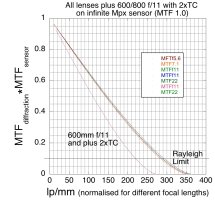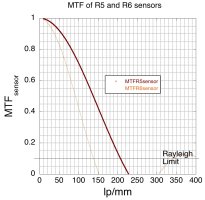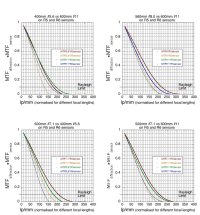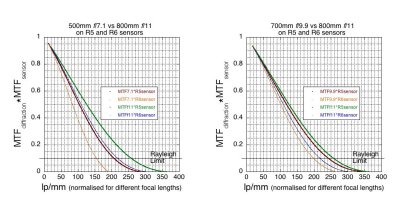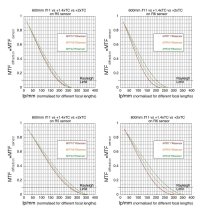Another of my geek articles, which does have some implications for actual use. What I do here is to calculate the contributions of diffraction and sensor Mpx size (R5 vs R6) to the resolving power of the 400mm f/5.6 and 500mm f/7.1 zooms and the 600mm and 800mm f/11 primes and how resolution is affected by 1.4x and 2x teleconverters.
The summary based on just the effects of diffraction and sensor Mpx, and ignoring optical aberrations is:
The summary based on just the effects of diffraction and sensor Mpx, and ignoring optical aberrations is:
- On an unrealistically high-resolution sensor, the f5.6, f/7.1 zooms and the 800mm f/11 would all have the same resolution and outresolve the 600mm f/11, and the TCs would not increase resolution.
- As the number of pixels on the sensor decreases, increasing focal length becomes increasingly advantageous.
- The 100-400mm at 400mm f/5.6 is slightly outresolved by the 600mm f/11 on the R5 and more so on the R6.
- The100-400mm f/5.6 + 1.4xTC at 560mm f/8 outresolves the 600mm f/11 on the R5 and the two lenses are similar on the R6
- The 100-500mm f/7.1 outresolves the 100-400mm f/5.6 and 600mm f/11 on the R5 and R6
- The 800mm f/11 outresolves the 100-500mm f/7.1 on the R5 and R6, but adding the 1.4xTC to the zoom brings it closer to the 800mm prime.
- Using the 1.4x and 2xTCs on the f/11 lens hardly increases the resolution on the R5 and only a little more on the R6. Further, any additional aberration added by the TCs could well render them even worse.
- The f/11 lenses are more suited to the lower resolution R6, and this makes it an attractive lower priced alternative.
Last edited:

